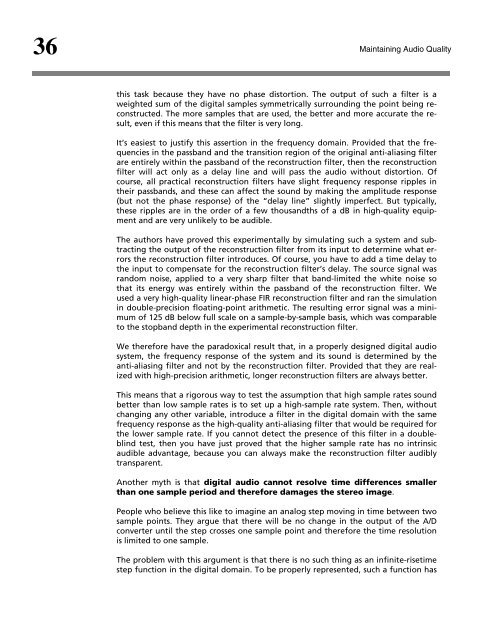Maintaining Audio Quality in the Broadcast Facility 2011 - Orban
Maintaining Audio Quality in the Broadcast Facility 2011 - Orban
Maintaining Audio Quality in the Broadcast Facility 2011 - Orban
Create successful ePaper yourself
Turn your PDF publications into a flip-book with our unique Google optimized e-Paper software.
36<br />
<strong>Ma<strong>in</strong>ta<strong>in</strong><strong>in</strong>g</strong> <strong>Audio</strong> <strong>Quality</strong><br />
this task because <strong>the</strong>y have no phase distortion. The output of such a filter is a<br />
weighted sum of <strong>the</strong> digital samples symmetrically surround<strong>in</strong>g <strong>the</strong> po<strong>in</strong>t be<strong>in</strong>g reconstructed.<br />
The more samples that are used, <strong>the</strong> better and more accurate <strong>the</strong> result,<br />
even if this means that <strong>the</strong> filter is very long.<br />
It’s easiest to justify this assertion <strong>in</strong> <strong>the</strong> frequency doma<strong>in</strong>. Provided that <strong>the</strong> frequencies<br />
<strong>in</strong> <strong>the</strong> passband and <strong>the</strong> transition region of <strong>the</strong> orig<strong>in</strong>al anti-alias<strong>in</strong>g filter<br />
are entirely with<strong>in</strong> <strong>the</strong> passband of <strong>the</strong> reconstruction filter, <strong>the</strong>n <strong>the</strong> reconstruction<br />
filter will act only as a delay l<strong>in</strong>e and will pass <strong>the</strong> audio without distortion. Of<br />
course, all practical reconstruction filters have slight frequency response ripples <strong>in</strong><br />
<strong>the</strong>ir passbands, and <strong>the</strong>se can affect <strong>the</strong> sound by mak<strong>in</strong>g <strong>the</strong> amplitude response<br />
(but not <strong>the</strong> phase response) of <strong>the</strong> “delay l<strong>in</strong>e” slightly imperfect. But typically,<br />
<strong>the</strong>se ripples are <strong>in</strong> <strong>the</strong> order of a few thousandths of a dB <strong>in</strong> high-quality equipment<br />
and are very unlikely to be audible.<br />
The authors have proved this experimentally by simulat<strong>in</strong>g such a system and subtract<strong>in</strong>g<br />
<strong>the</strong> output of <strong>the</strong> reconstruction filter from its <strong>in</strong>put to determ<strong>in</strong>e what errors<br />
<strong>the</strong> reconstruction filter <strong>in</strong>troduces. Of course, you have to add a time delay to<br />
<strong>the</strong> <strong>in</strong>put to compensate for <strong>the</strong> reconstruction filter’s delay. The source signal was<br />
random noise, applied to a very sharp filter that band-limited <strong>the</strong> white noise so<br />
that its energy was entirely with<strong>in</strong> <strong>the</strong> passband of <strong>the</strong> reconstruction filter. We<br />
used a very high-quality l<strong>in</strong>ear-phase FIR reconstruction filter and ran <strong>the</strong> simulation<br />
<strong>in</strong> double-precision float<strong>in</strong>g-po<strong>in</strong>t arithmetic. The result<strong>in</strong>g error signal was a m<strong>in</strong>imum<br />
of 125 dB below full scale on a sample-by-sample basis, which was comparable<br />
to <strong>the</strong> stopband depth <strong>in</strong> <strong>the</strong> experimental reconstruction filter.<br />
We <strong>the</strong>refore have <strong>the</strong> paradoxical result that, <strong>in</strong> a properly designed digital audio<br />
system, <strong>the</strong> frequency response of <strong>the</strong> system and its sound is determ<strong>in</strong>ed by <strong>the</strong><br />
anti-alias<strong>in</strong>g filter and not by <strong>the</strong> reconstruction filter. Provided that <strong>the</strong>y are realized<br />
with high-precision arithmetic, longer reconstruction filters are always better.<br />
This means that a rigorous way to test <strong>the</strong> assumption that high sample rates sound<br />
better than low sample rates is to set up a high-sample rate system. Then, without<br />
chang<strong>in</strong>g any o<strong>the</strong>r variable, <strong>in</strong>troduce a filter <strong>in</strong> <strong>the</strong> digital doma<strong>in</strong> with <strong>the</strong> same<br />
frequency response as <strong>the</strong> high-quality anti-alias<strong>in</strong>g filter that would be required for<br />
<strong>the</strong> lower sample rate. If you cannot detect <strong>the</strong> presence of this filter <strong>in</strong> a doublebl<strong>in</strong>d<br />
test, <strong>the</strong>n you have just proved that <strong>the</strong> higher sample rate has no <strong>in</strong>tr<strong>in</strong>sic<br />
audible advantage, because you can always make <strong>the</strong> reconstruction filter audibly<br />
transparent.<br />
Ano<strong>the</strong>r myth is that digital audio cannot resolve time differences smaller<br />
than one sample period and <strong>the</strong>refore damages <strong>the</strong> stereo image.<br />
People who believe this like to imag<strong>in</strong>e an analog step mov<strong>in</strong>g <strong>in</strong> time between two<br />
sample po<strong>in</strong>ts. They argue that <strong>the</strong>re will be no change <strong>in</strong> <strong>the</strong> output of <strong>the</strong> A/D<br />
converter until <strong>the</strong> step crosses one sample po<strong>in</strong>t and <strong>the</strong>refore <strong>the</strong> time resolution<br />
is limited to one sample.<br />
The problem with this argument is that <strong>the</strong>re is no such th<strong>in</strong>g as an <strong>in</strong>f<strong>in</strong>ite-risetime<br />
step function <strong>in</strong> <strong>the</strong> digital doma<strong>in</strong>. To be properly represented, such a function has



![[PDF] Using the ITU BS.1770-2 and CBS Loudness Meters ... - Orban](https://img.yumpu.com/50629372/1/190x245/pdf-using-the-itu-bs1770-2-and-cbs-loudness-meters-orban.jpg?quality=85)






![[PDF] Optimod-FM Feature Comparison - Orban](https://img.yumpu.com/41741615/1/190x245/pdf-optimod-fm-feature-comparison-orban.jpg?quality=85)






